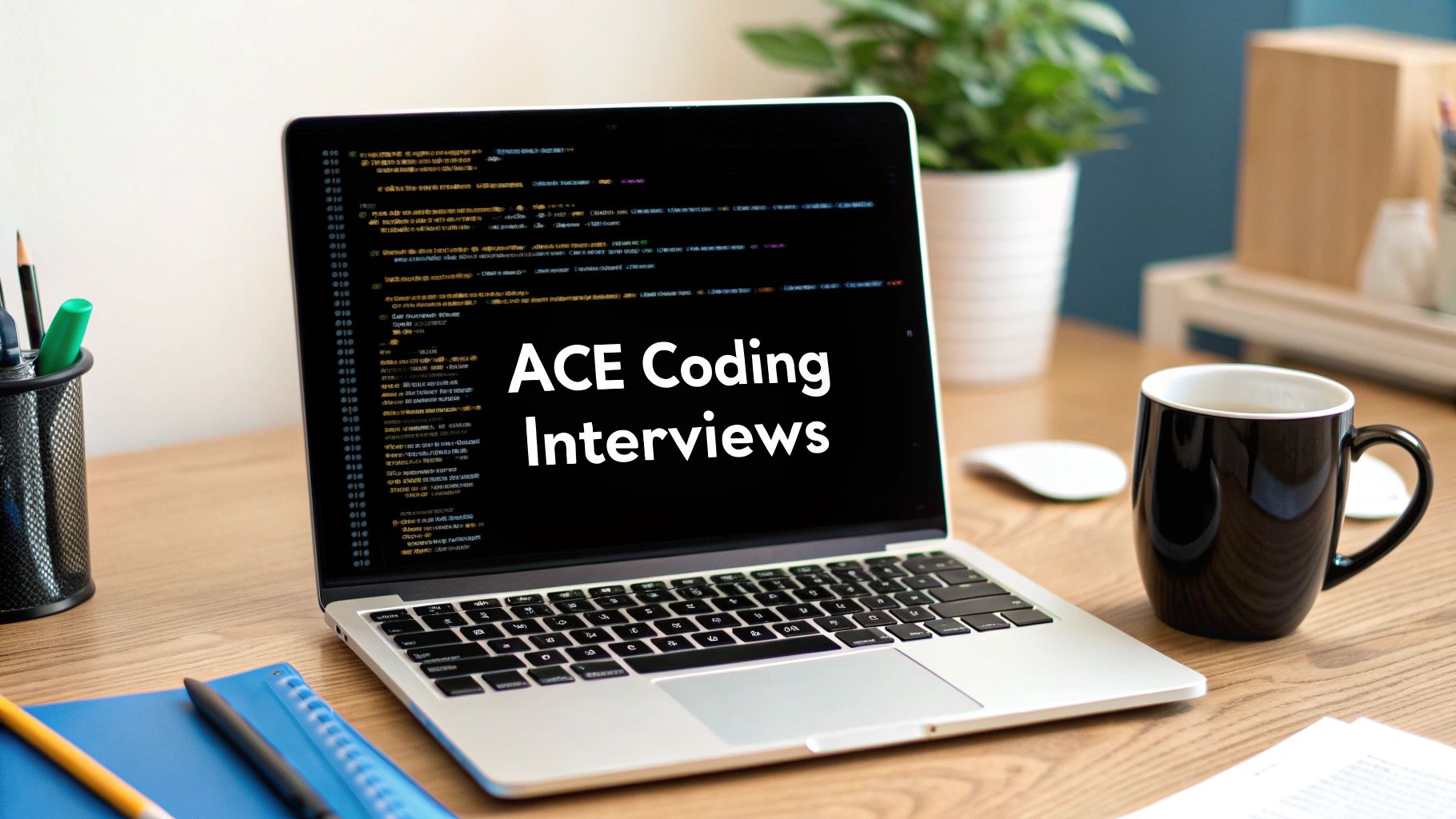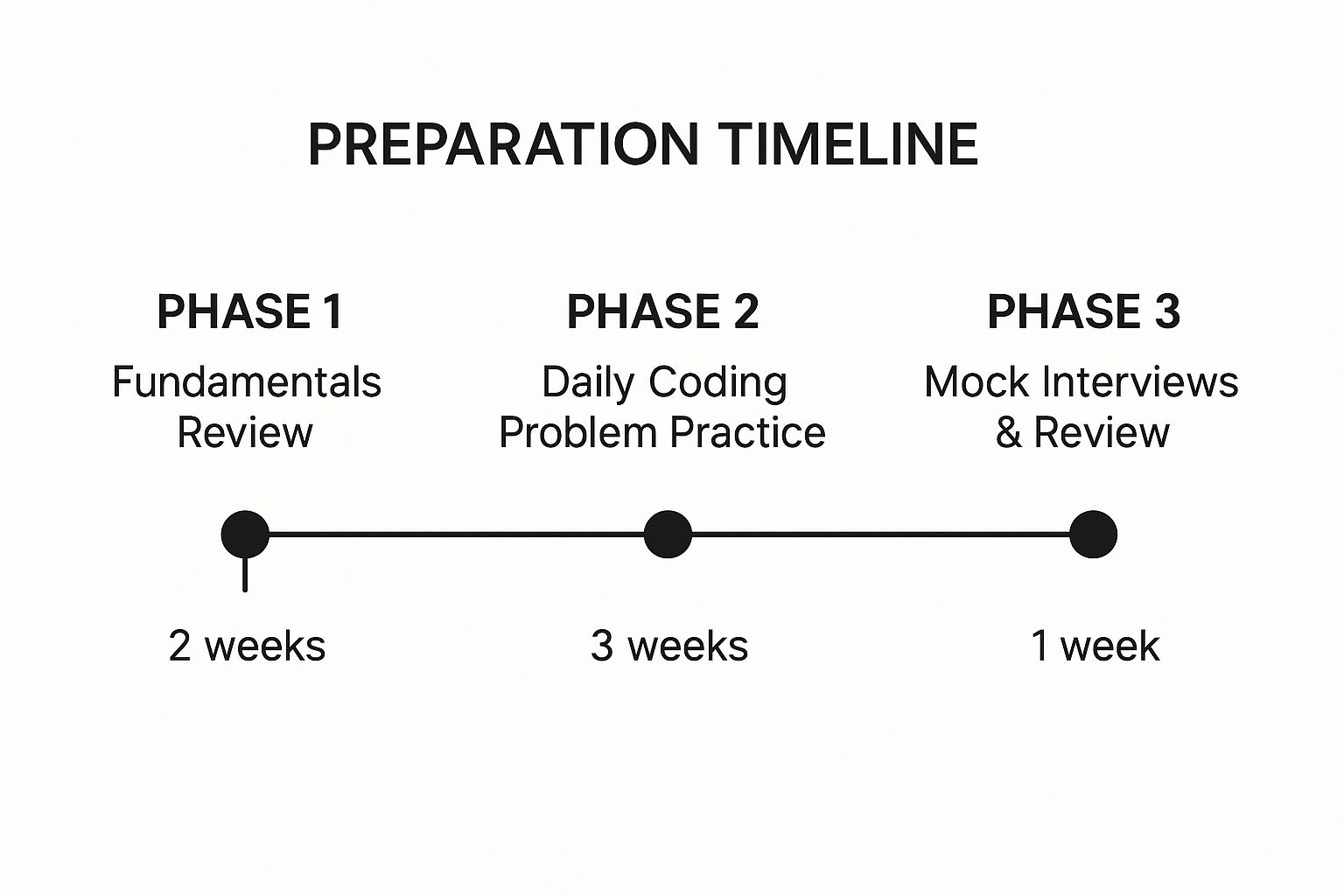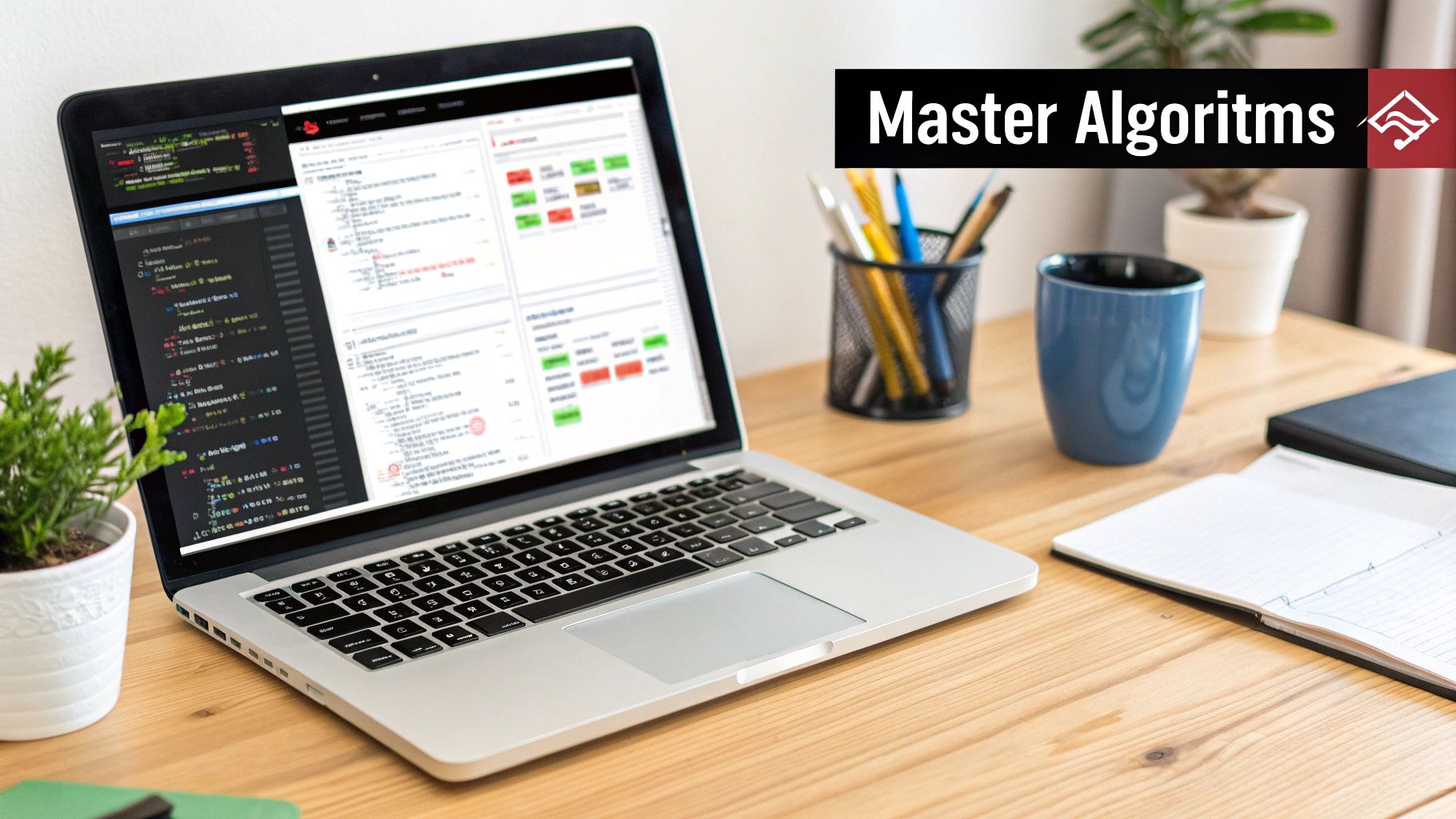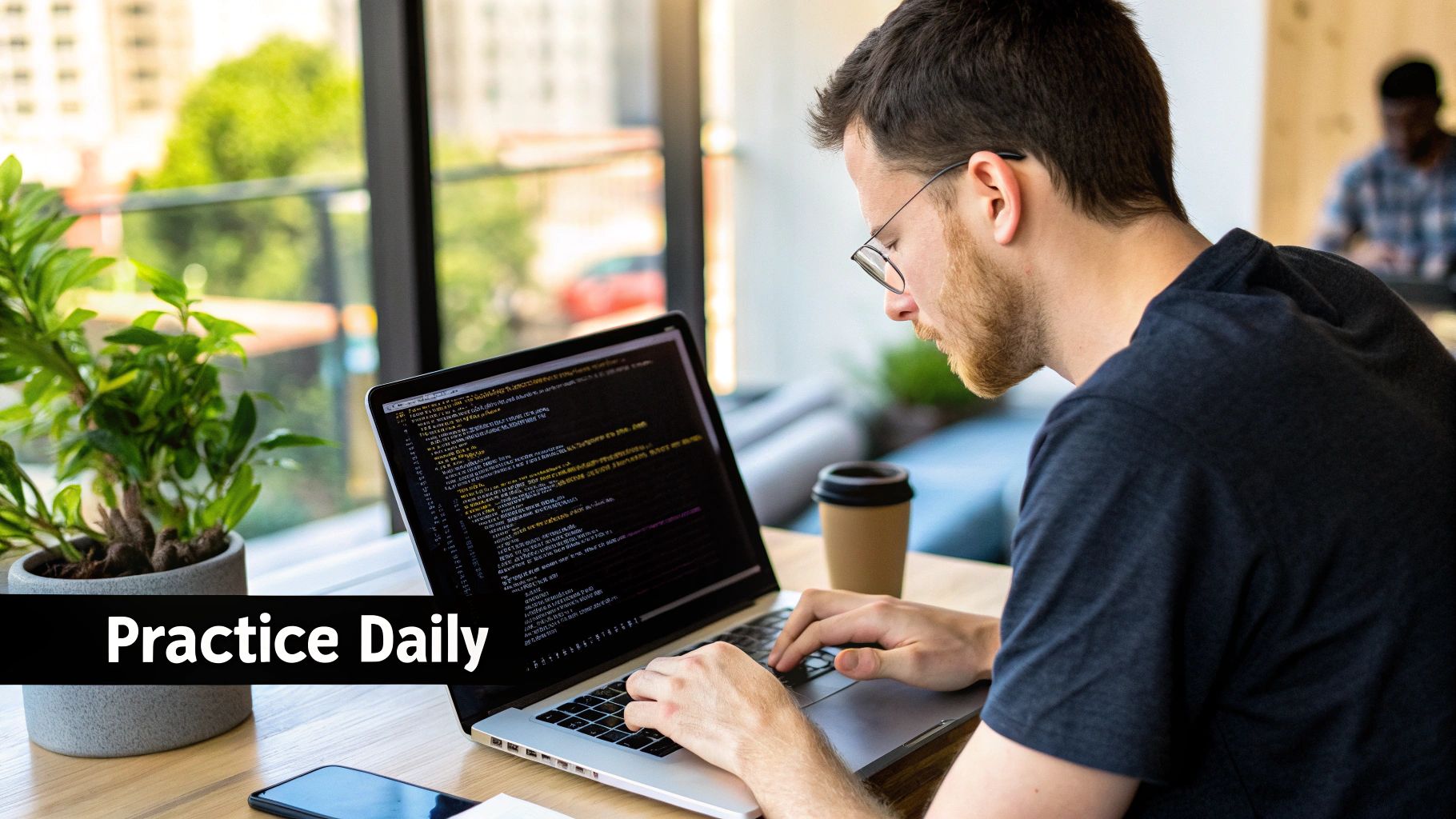How to Prepare for Coding Interviews: Your Complete Guide

Cracking a coding interview isn't just about grinding through problems. It’s a structured process that starts with a solid grasp of core data structures and algorithms, moves into regular practice on platforms like LeetCode, and finishes with mock interviews that get you comfortable with the pressure. This approach builds both your technical chops and the confidence you need to walk in and own it.
Your Realistic Coding Interview Roadmap
The path to nailing a technical interview is more of a marathon than a sprint. It's not about memorizing solutions to hundreds of problems; it's about building a deep, strategic foundation. So many engineers get overwhelmed by the sheer amount of stuff to learn, but a good roadmap can bring order to the chaos. The real goal isn't just to solve problems you've seen before—it's to develop the mental toolkit to confidently solve problems you've never seen.
Before you even think about complex algorithms, make sure you've got the basics of interviewing down. For a broader perspective, these expert tips and strategies for job interviews are a great resource for handling the non-technical side of things, which can be just as critical.
Choosing Your Tools Wisely
First things first: pick your programming language. Most companies don't care which one you use, but you absolutely need to be fluent in your choice. Python and Java are popular for a reason—Python's clean syntax lets you write less code to express complex ideas, while Java’s strict typing is a favorite in many big corporate environments.
But honestly, the best language is the one you know inside and out. You want to be focused on solving the problem, not wrestling with syntax. Stick to your comfort zone so your problem-solving skills can really shine.
Mastering the Core Fundamentals
With your language locked in, it's time to get serious about data structures and algorithms (DSA). These are the absolute bedrock of any technical interview. Don't just learn the definitions; you need to understand the trade-offs. Why use a hash map instead of an array? When is a linked list better? That's what interviewers are looking for.
Focus on mastering these essentials:
- Arrays and Strings: The building blocks for countless problems.
- Linked Lists: Great for understanding pointers and memory.
- Hash Maps (Dictionaries): Your key to O(1) lookups and highly optimized solutions.
- Trees and Graphs: The bread and butter of more complex challenges.
- Stacks and Queues: Essential for a wide range of traversal and search algorithms.
The real test isn’t whether you can define a binary tree. It's knowing when a binary tree is the right tool for the job. True mastery is all about application, not just memorization.
This infographic lays out what a well-structured preparation plan looks like over a few months.

As you can see, the idea is to build your skills in phases. You start with the basics, then ramp up the intensity with problem-solving, and finally, you polish your performance with mock interviews. This gradual approach helps you avoid burnout while steadily building your skills.
Creating a Practical Study Timeline
Okay, you know what to study. Now, let's build a timeline. Be honest with yourself here. Where are you starting from, and how much time can you realistically commit each week? This stuff is hard—over 60% of software engineers say coding interviews are the toughest part of getting a job.
Here’s a sample timeline to give you an idea of how to structure your prep over three months. It's just a template, so feel free to adjust it based on your own schedule and starting point.
Sample 3-Month Coding Interview Preparation Timeline
| Month | Weekly Focus | Time Commitment (per week) |
|---|---|---|
| Month 1 | DSA Fundamentals: Deep dive into one or two data structures per week (e.g., Arrays, Strings, Linked Lists, Hash Maps). Solve Easy LeetCode problems. | 5-8 hours |
| Month 2 | Algorithmic Patterns: Focus on common patterns (e.g., Two Pointers, Sliding Window, BFS/DFS). Transition to Medium LeetCode problems. | 8-12 hours |
| Month 3 | Mock Interviews & Advanced Topics: Do 1-2 mock interviews per week. Tackle Hard problems and review company-specific question lists. | 10-15 hours |
A balanced plan like this keeps you from getting in over your head too quickly. Start with easier questions to get some wins and build momentum before moving on to tougher challenges.
Remember, consistency is way more important than intensity. Five focused hours every week for a few months will do a lot more for you than a 20-hour cram session the weekend before your interview. Think of this roadmap as your personal guide to success.
Developing a Problem-Solving Mindset
The best interview performances aren't about rote memorization. They're about showing you have a reliable way to tackle problems you've never encountered. This is where you demonstrate how you think, which is infinitely more valuable to an interviewer than just spitting out a perfect solution. It's your chance to turn a complex challenge into a collaborative, structured discussion.
So, where do you start? The moment you get the problem. Resist the urge to dive headfirst into coding. Your first move should always be to clarify. Ask probing questions to nail down the constraints, edge cases, and expected outputs. Are we dealing with only positive integers? What happens if the input string is null or empty? This back-and-forth isn't just about avoiding a misunderstanding; it shows you're methodical and don't make assumptions.
Think Out Loud—It's Non-Negotiable
Your interviewer can't read your mind, so you have to be the narrator of your own thought process. A great way to begin is by explaining the most straightforward, brute-force solution. It might be clunky and inefficient, but it proves you understand the fundamentals of the problem and gives you a baseline to improve upon.
From there, you can start talking through optimizations. For example, you might say, "Okay, the brute-force way is O(n²), which isn't great. I bet we can get this down to O(n) if we use a hash map to keep track of the values we've already seen." This verbal walkthrough turns the interview from an interrogation into a collaborative session, letting the interviewer follow your logic every step of the way.
Spotting the Patterns in the Code
Here's a secret: most coding interview questions are just dressed-up versions of common algorithmic patterns. Getting good at recognizing these patterns is a massive advantage. Instead of a totally new problem, you'll see a familiar structure you already know how to handle.
A few of the most critical patterns you need to master include:
- Two Pointers: Incredibly useful for sorted arrays or linked lists when you need to find a pair of elements that fit specific criteria.
- Sliding Window: Your go-to for array or string problems that ask for an optimal subarray or substring, like finding the longest substring with no repeating characters.
- Breadth-First Search (BFS) / Depth-First Search (DFS): Essential for any problem involving trees or graphs, whether you're finding the shortest path or just exploring all the nodes.
There's no better place to practice this than on platforms like LeetCode.

They categorize their problems by topic, so you can drill down on one pattern until it becomes second nature.
It’s All About the Trade-Offs: Time and Space Complexity
Once you have a solution in mind, you need to be able to analyze its efficiency using Big O notation. This isn't just an academic exercise; it's how you justify your technical decisions. You have to clearly explain the trade-offs between your solution's time complexity (how quickly it runs) and its space complexity (how much memory it uses).
A hash map, for instance, might get you to a zippy O(n) time complexity, but it’ll cost you O(n) in space. Is that an acceptable trade-off? That depends entirely on the problem's constraints. Discussing these nuances proves you write code that is not only correct but also scalable and efficient—a core competency for any serious engineering role.
Your ability to defend your architectural choices is just as important as your ability to code them. An interviewer wants to see that you can weigh different approaches and select the most appropriate one for the given context.
This framework—clarify, communicate, pattern-match, and analyze—is a repeatable process that will build both your confidence and your consistency. If you want to take your problem-solving to the next level, it can help to find ways to spark your creativity and look at challenges from new angles. Ultimately, this mindset transforms the interview from a nerve-wracking test into the kind of collaborative problem-solving session that top companies want to see.
How to Practice for Real Improvement

Let’s be honest: just grinding through hundreds of problems is a fast track to burnout, not a job offer. The real secret to getting ready for a coding interview is to practice smarter, not just harder. It’s all about having a structured approach that builds real skill, confidence, and the kind of muscle memory you need when the pressure is on.
A solid plan goes way beyond just solving problems. It should involve realistic simulations, thoughtful reflection, and a smart way to learn from your mistakes. Every hour you put in should be an hour that actually moves the needle.
Build a Balanced Practice Schedule
I've seen so many engineers make one of two mistakes: they either stick to easy problems for the confidence boost or they jump straight into the deep end with hard problems and get totally discouraged. Neither works. A balanced schedule that mixes up the difficulty is far more effective.
Try to build a weekly routine that looks something like this:
- Easy Problems: Think of these as your warm-ups. They’re great for reinforcing fundamental concepts and getting your speed up.
- Medium Problems: This is your bread and butter. Most of your time should be spent here, as these questions are the closest to what you'll actually face in an interview.
- Hard Problems: You don't need to do dozens of these. Just try one or two a week to really stretch your brain and get comfortable with complex, multi-step logic.
This mix keeps your foundation strong while constantly pushing you to grow. For most people, setting aside around 11 hours per week is a great target. This gives you enough time to really dig into data structures and algorithms while still getting in consistent practice.
The Power of Timed Mock Interviews
Solving a problem with unlimited time is one thing. Doing it in 45 minutes with an interviewer watching your every move is a completely different ballgame. Timed mock interviews are, without a doubt, the single best way to prepare for the real thing.
You have a few great options here:
- Peer Interviews: Grab a friend or find a study partner online. Take turns interviewing each other. It’s incredibly valuable because you get to see things from both sides of the table—both explaining your own thought process and trying to understand someone else's.
- Formal Platforms: Services that connect you with other engineers for anonymous, structured mock interviews can be fantastic. They give you a more realistic and unbiased experience.
- Solo Mock Interviews: Don't sleep on this one! Set a timer, pick a random problem, and talk through your entire solution out loud as if you were explaining it to an interviewer. Record yourself and watch it back. You'll be amazed at what you notice.
Acing a coding interview is as much about performance and communication as it is about technical skill. Mock interviews train you to stay calm, articulate your thoughts clearly, and manage the clock—skills that only come with practice.
Use Modern Tools to Sharpen Your Skills
Practicing efficiently also means using the right tools for the job. Platforms like ParakeetAI can be a huge help here, acting as a smart study assistant. You can use it to generate practice questions on specific topics you're struggling with, like dynamic programming or tricky graph traversals.
What's more, getting instant feedback on your code is a game-changer. Instead of just checking the solution after you're done, these tools can help you spot inefficiencies or point out alternative approaches you might have missed. That immediate feedback loop speeds up learning immensely. To see how tech can help, you can find more tips on the ParakeetAI blog.
Turn Mistakes into Learning Opportunities
Every single mistake you make in practice is a gift. It's a flashing red light showing you exactly where you need to get stronger before it counts. The trick is to be systematic about how you learn from those errors.
Start keeping an error log. It doesn't have to be anything fancy—a simple spreadsheet or a note-taking app is perfect.
For every problem that stumped you or you got wrong, jot down:
- Problem Name & Link: Makes it easy to revisit.
- The Mistake: Be brutally honest. Did you pick the wrong data structure? Was it a simple off-by-one error? Did you just freeze up?
- The Key Insight: What was the "aha!" moment that finally made it click? Write it down in your own words.
- Related Pattern: Tag the problem with the core pattern it uses (e.g., Sliding Window, Two Pointers, BFS).
Take 15 minutes each week to review this log. You'll start to see patterns emerge, which tells you exactly where you need to focus your energy. This process ensures that every practice session—even the frustrating ones—is a genuine step forward.
Acing the Behavioral Interview Round

Let's be honest: your technical skills get your foot in the door. But it's your ability to communicate, collaborate, and handle real-world friction that actually lands you the job. So many talented engineers grind away on algorithms and data structures, only to get completely blindsided by a simple question like, "Tell me about a time you had a conflict with a teammate."
This non-technical round is where the hiring manager decides if you're someone they actually want to work with every day.
Think of it as a critical filter. A brilliant coder who can't function within a team isn't an asset; they're a liability. Your mission in the behavioral interview is to prove you're not just a great problem-solver, but also a valuable and reliable colleague. Nailing this part of the process is absolutely non-negotiable.
Crafting Your Career Stories with the STAR Method
The single most powerful tool in your behavioral interview toolkit is the STAR method. It’s a simple, effective framework that helps you turn your experiences into compelling stories that actually answer the question being asked. Vague, rambling answers are a huge red flag. You need a narrative with a clear beginning, middle, and end.
Here’s the breakdown:
- Situation: Quickly set the scene. What was the project? What was the context? Give just enough background for the story to make sense without getting bogged down in jargon.
- Task: What was your specific goal or responsibility? What problem were you trying to solve?
- Action: This is where you shine. Detail the specific steps you took to handle the task. Focus on your personal contributions, even if it was a group effort. Always use "I" statements, not "we."
- Result: So, what happened? Explain the outcome of your actions. Whenever you can, quantify it. Did you improve efficiency by 15%? Did you reduce server response time by 200ms? Numbers speak volumes.
The STAR method is your guardrail against rambling. It forces you to be concise, making sure every sentence adds value and directly addresses what the interviewer wants to know.
Building Your Story Arsenal
You don't need a different story for every possible question they might throw at you. That's impossible. Instead, the smart approach is to prepare 5-7 core stories from your career that are versatile enough to be adapted on the fly.
Think of these stories as your "greatest hits." They should cover a range of common themes and showcase different skills:
- A time you navigated a major conflict with a coworker.
- A project where you stepped up and showed leadership.
- An instance where you failed, made a big mistake, and what you learned from it.
- A particularly nasty technical challenge you wrestled to the ground.
- A moment you had to influence others or push back on a decision.
For example, a single story about a missed deadline could be framed to answer questions about failure, time management, or how you handle pressure. By having these core narratives locked and loaded, you can confidently tackle almost any question without freezing up.
Aligning with Company Values
Every company has a culture, and they signal it through their core values. Whether it's "customer obsession," "bias for action," or "move fast and break things," these aren't just buzzwords on a website—they're what hiring managers are actively looking for.
Before any interview, spend 30 minutes on the company's "About Us" or "Careers" page. Get familiar with their mission and values.
Listen for these keywords during the conversation and subtly weave them into your STAR stories. If a company preaches collaboration, make sure your story about that big team project highlights how you solicited feedback and shared credit. It’s a simple trick that shows you’ve done your homework and are a potential cultural fit.
Finally, always have a few thoughtful questions ready for them. Asking about their team's biggest challenges, the engineering culture, or what success looks like in the first six months shows genuine interest. It flips the script from a one-sided interrogation to a two-way conversation, which is exactly the kind of lasting impression you want to leave.
Navigating the Final Interview Loop
Think of the final interview loop less as a single interview and more as an endurance event. You're about to face a gauntlet of back-to-back sessions, each one designed to test a different facet of who you are as an engineer—from your raw technical chops to how well you handle pressure and collaborate with a team.
Success at this stage isn't just about getting the right answers. It's about managing your energy, staying sharp for hours on end, and consistently showing the best version of yourself. This is where all your hard work preparing for the coding interview really comes to a head. It’s a marathon, not a sprint, and having a game plan for the day itself is a huge advantage.
Onsite Interview Round Types and Focus Areas
Your final loop will almost certainly be a mix of different interview formats. While every company has its own flavor, most pull from a standard set of interview types. Knowing what's coming helps you mentally prepare to shift gears between drastically different conversations.
Here's a quick look at the most common rounds you'll likely run into.
| Interview Type | Primary Focus | Key Skills to Demonstrate |
|---|---|---|
| Data Structures & Algorithms | Pure problem-solving and coding, usually on a whiteboard or in a shared editor. | Clearly explaining your thought process, writing clean code, and analyzing time/space complexity. |
| System Design | High-level architectural thinking, breaking down complex systems, and weighing trade-offs. | Handling ambiguity gracefully, discussing trade-offs, and defending your design choices. |
| Behavioral/Managerial | Gauging your fit with the team and company culture, and learning from your past experiences. | Telling structured stories (the STAR method works wonders), showing self-awareness, and asking thoughtful questions. |
| Project Deep Dive | A detailed walkthrough of a significant project you’ve listed on your resume. | Demonstrating ownership, technical depth, and a clear understanding of your project's business impact. |
Each one of these sessions demands a different part of your brain. One minute you're deep in the weeds of a tricky algorithm, and the next, you're expected to zoom out and discuss high-level architecture. The ability to hit the reset button and refocus between rounds is a skill that separates good candidates from great ones.
Communicating Under Pressure
When you’re trying to solve a tough problem with someone watching your every move, it’s easy for your communication to break down. But this is exactly when it matters most. You will hit a problem you don’t immediately know how to solve. Don't panic. This is actually your moment to shine.
Start by talking through what you understand about the problem and asking clarifying questions to fill in any gaps. It's perfectly fine to begin with a brute-force solution. For example, you could say, "Okay, a simple way to approach this would be to do X, but I know that won't be very efficient because of Y. I think we can do better if we try Z instead." This shows the interviewer you have a methodical, structured way of thinking.
The interviewer is often more interested in how you navigate uncertainty than in whether you find the perfect answer instantly. A collaborative, vocal approach to problem-solving is far more impressive than struggling in silence.
Post-Interview Professionalism and Negotiation
The process isn't over when you walk out the door or sign off the video call. Following up with a brief, personalized thank-you email within 24 hours is a simple professional courtesy that reinforces your interest. Try to mention a specific point you enjoyed discussing with each interviewer—it makes your note much more memorable.
And if that offer comes through? Congratulations! Now comes the final step: negotiation. This is a completely standard part of the hiring process, and good companies expect it. Before you talk numbers, do your research on what the market rate is for your role, level, and location.
When you have that conversation, stay polite and professional, and anchor your requests in the data you've found and the value you bring. Confidently navigating this last discussion ensures you not only land the job but also start your new role feeling valued and fairly compensated. It’s the perfect way to wrap up your interview journey.
Answering Your Biggest Interview Questions
When you're grinding through interview prep, a lot of questions pop up that go beyond just code. How much is enough? What if I blank on a question? Let's clear up some of the most common worries I hear from engineers so you can walk into your next interview with a solid game plan.
How Many LeetCode Problems Is Enough?
Everyone wants a magic number, but the honest answer is it's about quality, not quantity. Forget the vanity metric of hitting 500 problems. Instead, your goal should be to deeply understand the patterns behind 150-200 carefully selected problems. A scattergun approach where you just blast through as many as possible is a recipe for burnout, not success.
Mastery isn't about memorizing a thousand solutions; it's about recognizing a pattern in a new problem and knowing exactly which tools to apply. You need a balanced diet of problems to get there.
- Easy problems are your warm-ups. They build confidence and make sure you have the basics down cold.
- Medium problems are the main course. This is where you'll spend most of your time, as they're the closest to what you'll actually see in an interview.
- Hard problems are for when you're feeling sharp. They push your limits and get you ready for the curveballs thrown at top-tier companies.
One hour spent dissecting a tough problem—whiteboarding different approaches, analyzing time/space trade-offs—is infinitely more valuable than mindlessly coding five easy ones to bump up your solved count.
What's the Best Programming Language for a Coding Interview?
Simple: the one you're most fluent in. Your brain has a finite amount of processing power, and you want to spend all of it on the algorithm, not trying to remember how to sort a dictionary or split a string.
Python and Java are popular for a reason. Python’s clean syntax lets you write out complex ideas without a lot of boilerplate, which is a lifesaver when the clock is ticking. Java is an enterprise workhorse, and its strong typing can help prevent silly mistakes under pressure.
But if you live and breathe C++ or JavaScript, stick with it. Seriously. An interviewer will be far more impressed by a clean, elegant solution in a language you’ve mastered than a clunky, hesitant one in a language you think they prefer. The language is just the tool; your thinking is what's being evaluated.
What if I Get a Problem I've Never Seen Before?
First, don't panic. Take a breath. This is completely normal and often intentional. Interviewers want to see how you handle the unknown, not just whether you've memorized the "right" answer. This is your chance to show them how you think.
The worst thing you can do is go silent. Instead, start talking.
- Parrot it back. Rephrase the problem in your own words to the interviewer. This ensures you're both on the same page from the get-go.
- Ask smart questions. Start poking at the edges. "What happens if the input is an empty array?" or "Can I assume the numbers are all positive integers?" This shows you're thinking about edge cases.
- Start with the obvious. Talk through the brute-force solution first, even if you know it's slow. Saying something like, "Okay, my first instinct is a nested loop, which would be O(n²). I know we can do better, but it's a starting point..." shows you have a process.
- Think out loud. Brainstorm optimizations with your interviewer. "Maybe a hash map could help us get this down to O(n) time by trading off some space..." This turns a stressful interrogation into a collaborative problem-solving session.
Even if you don't land on the picture-perfect optimal solution, demonstrating a calm, structured, and communicative thought process is a huge win. They're hiring a problem-solver, not a walking encyclopedia of algorithms.
Ready to feel more confident in your next interview? ParakeetAI provides real-time assistance, helping you articulate your thoughts clearly and tackle tough questions with ease. Stop worrying and start preparing smarter by visiting https://www.parakeet-ai.com to get the support you need.




